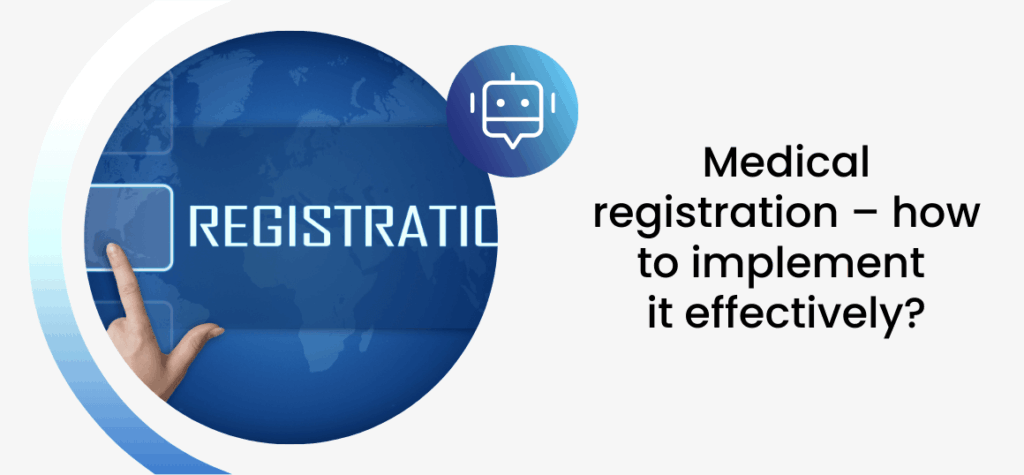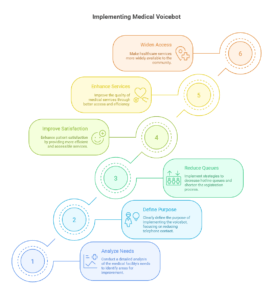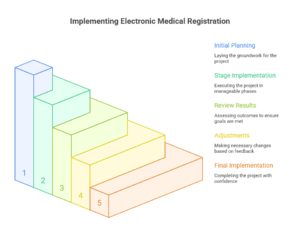Medical registration – how to implement it effectively?

Medical registration – how to implement it effectively?
In recent years, electronic medical registration has become almost a standard in modern healthcare facilities. Both private and public healthcare providers are increasingly deciding to implement such systems. In this article, we have gathered the most important information on how to introduce electronic patient registration effectively and smoothly.
Step one: A thorough analysis of the medical facility’s needs
Naturally, the starting point should be a detailed analysis of the facility’s real needs. Above all, the purpose of such an implementation must be clearly defined. Most often, the goal is to reduce the burden of telephone contact in favor of increasing the number of medical appointments registered through a medical voicebot. This approach helps decrease hotline queues and shortens the entire registration process. As a result, patient satisfaction improves, the quality of medical services rises, and access to care becomes more widely available. During implementation, it is also essential to consider the challenges faced by call center staff and the overall scale of healthcare services provided.

Establishing a project team
Once the decision to implement an electronic patient registration system has been made, a dedicated project team should be selected. It should include people responsible for carrying out the entire process and supervising the implementation. Ideally, at least one member should have technical expertise. A standard team typically consists of an IT specialist, a medical registration employee, a physician, and a member of the healthcare facility’s management board. This way, a broad range of competencies is brought together. Moreover, it ensures that the system is viewed from different perspectives within the clinic’s organizational hierarchy. Such an approach makes it possible to address a wider scope of needs and to select functionalities that provide tangible benefits without generating unnecessary costs. Every implementation should be tailored both technologically and financially.
Choosing the right electronic patient registration system
Once the objectives and assumptions of the implementation have been established, the next step is to choose the right system. It should address the key needs of the medical facility. That is why it is crucial that the solution is tailored to the specific requirements. At the same time, the system should be intuitive, easy to use, and reliable even under heavy loads. Data security, functionality, and the price-to-performance ratio must also be considered. When customizing the system to the needs of a medical facility, aspects such as specialist doctors’ calendar settings, appointment types, notification configuration, appointment confirmations, and cancellation rules should be taken into account. The more factors you consider, the better. That’s why contacting an expert is often the best choice—an AI voicebot specialist can help you fine-tune the parameters of electronic patient registration for your clinic.
Integrating medical registration with the facility’s IT system
From a usability perspective, it is vital that the external medical registration system can integrate with other tools already used at the facility. Before implementation, it should be verified whether the voicebot can integrate with existing systems such as EHR/EDM, e-referrals, and e-prescriptions. There is no room for errors here, as integration gaps could limit or complicate the staff’s work in the future. It is therefore worth reviewing the expertise of solution providers who specialize in the healthcare sector. In practice, examining their past case studies is invaluable—especially those that closely resemble the needs of your clinic. Any doubts regarding integration should always be clarified directly with the service provider’s representative.
Testing the system in practice
One of the most critical stages of implementing electronic medical registration is testing. This involves creating test scenarios and running registrations without linking them to real calendars. Test calls help evaluate the system’s efficiency and effectiveness. Each module is verified—for example, appointment cancellation or visit reminders. Integration with other systems in the facility is also thoroughly tested. Everything must be finalized before patients gain access to the registration system. As part of the simulation, the system’s resilience to heavy loads is tested, including handling multiple or even dozens of simultaneous calls. Such situations are common in medical facilities, where patients typically wait in long queues. Electronic registration, however, allows many conversations to be conducted at once. This not only saves patients time but also significantly improves their satisfaction with the service.
Comprehensive training for medical reception staff on the new tool
In the context of effectively implementing an online medical registration system, comprehensive training for healthcare facility staff is crucial. Receptionists, administrative staff, and even doctors should be able to operate the system. This helps minimize the risk of errors that could result in longer registration times or overlapping patient appointments with specialists. Training should be tailored to each group, focusing on the functions they will use most often. Additionally, it is advisable to prepare emergency scenarios for potential technical issues. In such cases, registration should temporarily revert to the traditional method, and the service provider should be contacted immediately. The better the staff is prepared for such situations, the smoother the process will be. By choosing a reliable provider and a stable tool, the risk of complications is significantly reduced.
Porozmawiaj z naszym specjalistą
Informing patients about the implementation
The introduction of electronic patient registration is a transitional stage for both healthcare staff and patients. For patients, it represents an opportunity to streamline the process and eliminate missed calls. However, it requires patience, as this period can create challenges for both staff and patients as they adapt to the new system. It is therefore the responsibility of the healthcare facility to carry out an information campaign. This should include displaying clear posters in high-traffic areas of the clinic, sending out informational emails, and sharing updates via social media channels. Such actions help reach a larger number of patients, reduce the risk of misunderstandings, and improve the overall effectiveness of the implementation.
Monitoring initial results and optimization
Throughout the implementation process, the outcomes should be carefully monitored. This includes measuring the efficiency of the electronic registration system and tracking the number of errors made. Doing so makes it possible to identify areas that require optimization or additional staff training. At this stage, it is helpful to conduct interviews with medical staff to gather their feedback and understand potential challenges. Additionally, randomly contacting patients to learn about their experience provides valuable insights. Based on this feedback, optimization measures can be developed to improve the efficiency of daily operations.

